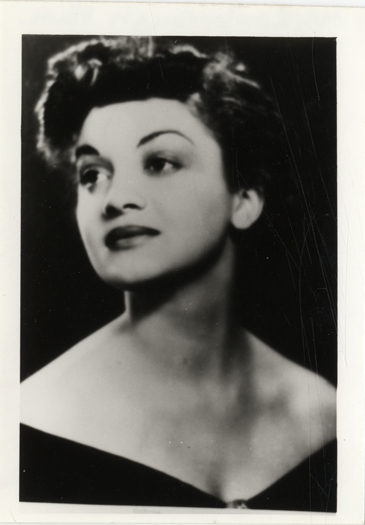Radmilla’s Voice: Music Genre, Blood Quantum, and Belonging on the Navajo Nation
Cultural Anthropology
Volume 29, Issu3 2 (May 2014)
pages 385-410
DOI: 10.14506/ca29.2.11
Kristina Jacobsen-Bia, Assistant Professor of Music
University of New Mexico
Window Rock, Navajo Nation, Arizona, September 1997. A young woman butchers a sheep as the crowd at the Navajo Nation Fairgrounds watches. Her hair tied back in a tsiiyéél, a woman’s hair bun, she wears a velvet top, silver concho belt, long satin skirt, and leather moccasins—the markers of traditional Navajo femininity. As she expertly slits the sheep’s throat to begin the arduous process of dissecting the animal, her skirt remains spotless: Not a drop of blood touches it.
Sheep butchering, a traditional Navajo art of subsistence, constitutes the first part of the Navajo Nation’s annual Miss Navajo pageant. The second is singing, and the same young woman—Radmilla Cody—performs a traditional “skip dance” song in the Navajo language. But something makes her performance different. As Radmilla’s voice carries across the fairground, she adds melismas, or vocal flourishes, note glides, and a bluesy inflection to the more nasal sound of traditional skip dance songs, which are typically sung by men (McAllester 1954). Onlookers cock their heads to listen more closely, and they hear for the first time the singer who will become known as the “Navajo Whitney Houston.” The crowd responds ecstatically; Radmilla, a twenty-one-year-old from Grand Falls, Navajo Nation, is publicly crowned the forty-sixth Miss Navajo Nation, 1997–1998.
When I introduced myself in Navajo to Radmilla in 2011 at a CD signing (for I had long been a fan of her music), she seemed amused to hear an Anglo, a bilagáana, speaking her language. She joked that we try performing some skip dance songs together in a perhaps improbable duo—a white woman and she, a half-black, half-Navajo one, performing old Navajo standards. As she autographed a glossy poster for my friend’s nine-year-old niece, who is of mixed Navajo, Korean, and French descent, she wrote in flowing cursive: “Beautiful you are! Many blessings to you. Always remember that, and walk in beauty.”
Radmilla dramatically broke the mold in more ways than one. There was, most obviously, her distinctive, hybrid singing at the intersection of Navajo tradition and African American rhythm and blues; that style reflected Radmilla’s own mixed heritage: she was the child of a Navajo (Tł’ááshchí’í clan) mother and a Naakai Łizhinii, or African American, father. In the documentary Hearing Radmilla (2010), she recalled being singled out as a child living on the Navajo reservation for her African American appearance, being perceived as different from other Navajos. There was also the later denouement to Radmilla’s story, her arrest in 2003 for aiding an abusive, drug-selling boyfriend and her subsequent attempt to rehabilitate her public image as a good citizen of the Navajo tribe. Fully fluent in Navajo and a citizen of the Navajo Nation, she embodied a unique story, and Radmilla’s voice became a lightning rod for reflection and debate about the twenty-first-century politics of race, blood, music genre, and belonging in Navajo country.
What, then, does Radmilla’s story reveal about the relationship between sound, racial identity, and blood quantum on the Navajo Nation? And what, in particular, can be said about the role of the singing voice in the politics of indigeneity? In this article, I use two case studies to show the tensions still surrounding black-Native parentage in Native American communities such as the Navajo (or Diné)5 and analyze reactions to Radmilla’s voice as a partial reflection of larger racial stereotypes about blackness and criminality that permeate U.S. society. These ideas tie crucially into issues of tribal citizenship in Native North America in the era of casinos, where the affective and political stakes of belonging have been dramatically raised, and citizenship and enrollment have come to signify more rigid demarcations between who belongs and who does not. Second, I demonstrate how sound itself becomes an “ethnic trope,” defined as symbols constructed as “allusions toward an ideal that has no living model” (Fast 2002, 23), where voice, musical genre, phenotype, and heritage-language skills index a speaker as more or less “authentically” Diné. Here, I distinguish sound from music, defining sound as a broader framework encompassing both music and language, which allows me to talk about the singing and speaking voice within a single frame. In Radmilla’s case, the supposedly black dimensions of both her phenotype and her traditional singing were used to single her out as less than fully Navajo. And, both in her crowning and in her run-in with the law, Radmilla’s identity as a celebrity gained what Daphne Patai (qtd. in Starn 2011, 123) has called “surplus visibility” about racial matters, “always put on the spot when controversy arises.”
Using my own fieldwork singing and playing with the Navajo country-western group, Native Country Band, as a counterpoint to Radmilla’s experience, I examine how individual and collective voices become marked by racial identities. On the one hand, her voice, perceived racial identity, and idiosyncratic singing style designated Radmilla as a cultural outsider. At the same time, in other contexts and because of her ability to broker generational differences in her choice of recorded material, her voice was celebrated as being quintessentially Navajo, securing her insider status as a Diné citize. Bringing sound into conversations about blood, belonging, and indigeneity, I show how racial identities become marked and investigate the role played by voice in this marking. Music and language both reflect and reinforce ideas of inclusion, exclusion, and communal reckoning in contemporary Navajo communities and in U.S. society at large (Harkness 2010; Feld et al. 2004). My larger contention becomes, in the case of Radmilla, the Navajo Nation, and the U.S. nation, that aesthetics—and voice and sound in particular—matter in relation to politics, albeit often in divergent ways and on differing scales…
Read the entire article here.



